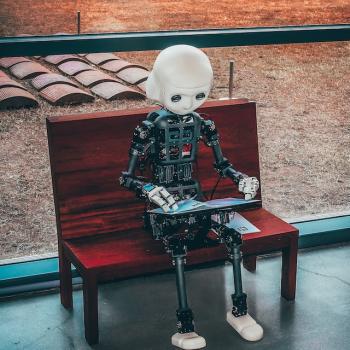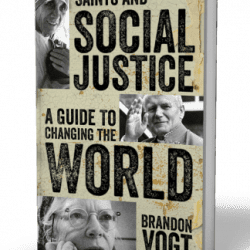Probably one of the reasons why Plato’s allegory of the cave is so famous is because of the applicability of its subject-matter to daily life. Any sense of insight we gain about the world around us makes us feel as if we are different, and we know how difficult it is to explain and convince others of that insight. People don’t want to listen to us. They don’t believe what we have to tell them. Critics even find plausible explanations to reject what we say, often with the suggestion that we are either deluded or ignorant. We all know the sensation of enlightenment combined with rejection by our peers.
It is not surprising that science fiction and fantasy writers often use Plato’s allegory as a means of telling a story. We can associate ourselves with the struggle a character has in trying to maintain their insight. And the struggle can be of various kinds, some mental, some physical, providing, as it were, an unlimited numbers of stories to be told. Some writers try to engage more of the elements of the allegory than others, taking in details which are not necessary but nonetheless useful to the reader. Such, for example, is the case with C.S. Lewis and Owen Barfield, two members of the Inklings. They both have stories which feature underground societies being kept in the dark about the world. They do so, however, for different reasons, each leading to their own insights about the human condition.
C.S. Lewis’ The Silver Chair has, at its basis, a refutation of the idea that religious experience is the delusional abstraction of ordinary life to fulfill one’s desires. In it, the main characters, Eustace, Jill, and Puddleglum, were sent by Aslan to find and rescue King Capsian’s son and heir, Rilian. He had been abducted by The Lady of the Green Kirtle, The Emerald Witch, and taken into her underground kingdom, where she has confused him by her charms, making him forget his past. She hoped to use him to lead a force of gnomes into invading and taking over Narnia. After the heroes find him and break her control over him, she is outraged. Nonetheless, she believes she can charm him and everyone else into believing the world of Narnia is unreal, thus regaining her control. When she employs her magic, everyone begins to forget about their past. They remember elements of it, and talk about it, like the land of Narnia, the sun, the woods, our world from which Eustace and Jill came from, etc. She tries to convince them their memories are wrong, and what they say exists is merely the abstraction of what they find in the underground realm. When asked about the sun they talk about, Prince Rilian described it in like a lamp, filled with light, but much bigger and in the sky. This is all the witch needed to make her argument:
You see? When you try to think out clearly what this sun must be, you cannot tell me. You can only tell me it is like the lamp. Your sun is a dream; and there is nothing in that dream that was not copied from the lamp. The lamp is the real thing; the sun is but a tale, a children’s story.[1]
Next, the witch challenged them upon the name of Aslan. Who and what is Aslan? When Eustace said he is a lion, and that a lion is like a big yellow cat with a mane, she responded:
‘I see,’ she said, ‘that we should do no better with your lion, as you call it, than we did with your sun. You have seen lamps, and so you imagined a bigger and better lamp and called it the sun. You’ve seen cats, and now you want a bigger and better cat, and it’s to be called a lion. Well, ‘tis a pretty make-believe, though, to say the truth, it would suit you better if you were younger. And look how you can put nothing into your make-believe without copying it from the real world, this world of mine, which is the only world. [….] I have work for you all in the real world. There is no Narnia, no Overworld, no sky, no sun, no Aslan…’[2]
Of course, those who are reading the story know the witch is lying; they are able to see through her charms. But it is in this way Lewis is capable of showing us how we reason things out, how we try to explain away that which we do not want to believe (or knowingly try to make people believe in falsehoods). We find another explanation, and hold on to it, even if it really does not have the logical weight we make it out as having. It’s easy to say religious experience is the delusion created by wish fulfillment, but it is another thing to prove it. If one already assumes religious experience to be faulty, one can find a reason to reject it; but that shows more about the assumption behind the rejection than it does anything else. Just because one can suggest a plausible explanation behind a phenomena does not mean they really have explained the phenomena. I can, of course, make plastic replicas of food, though I would be foolish to suggest that this means all food is likewise fake. Because there is the possibility that an experience could be faulty, we should not dismiss that suggestion out of hand either. Lewis provides an interesting way out of this quandary, one which could be said to be aesthetical: as we must accept there is something which is real, we must choose that which best fits our own aesthetic sense of what should be real, even if we cannot prove it is (in traditional philosophy, this is the argument of fittingness). And this is what Lewis puts into the mouth of Puddleglum:
Suppose we have only dreamed, or made up, all those things – tress and grass and sun and moon and stars and Aslan himself. Suppose we have. Then all I can say is that, in that case, the made-up things seem a good deal more important than the real ones. Suppose this black pit of a kingdom of yours is the only world. Well, it strikes me as a pretty poor one. And that’s a funny thing, when you come to think of it. We’re just babies making up a game, if you’re right. But four babies playing a game can make a play-world which licks your real world hollow. That’s why I’m going to stand by the play world. I’m on Aslan’s side even if there isn’t any Aslan to lead it. […] So, thanking you kindly for our supper, if these two gentlemen and the young lady are ready, we’re leaving your court at once and setting out in the dark to spend our lives looking for Overland. Not that our lives will be long, I should think; but that’s small loss if the world’s as dull a place as you say.[3]
Lewis, therefore, used the allegory of the cave to show us the nature of doubt, to show us how charming and yet unreliable its explanations can be. The question for Lewis is not whether or not we can prove the truth, but how fitting a presentation our worldview is. Truth must be beautiful; that which is merely ugly is not fit to be called the truth. And it is because it is attractive, because it is beautiful, we can have faith in the truth of revelation.
What makes Owen Barfield’s own allegory of the cave, Night Operation, so compelling is that he shows us what went in to the creation of the “cave.” It is a prophetic warning of where society is going. His is the world of the future, the world of the sewer. Biological terrorism made humanity burrow under the earth, into the sewers; its changes in education and social mores were ones which fit their new homeland. The three R’s – reading, writing and arithmetic, were rejected because they led to a kind of education that was not seen as conducive to democracy. “Some children acquire them more easily and apply than others and in doing so become different from those others. Obsessions with the three Rs belongs to the old twentieth-century ideal of equality of opportunity. Modern education aims at equality of result.”[4] As a replacement to the three Rs, the society of the future had the three Es, which became the foundation of their culture: “The three E’s were of course ejaculation, defecation and eructation.”[5] Education fit for sewage-dwellers, indeed. Reason is no longer emphasized. Despite this loss, this society saw human history was seen as aiming for this end; ancient history was reinterpreted in light of the new social situation, and the new, positive history was seen as true and anything else as fanciful.
Barfield allows old books to exist in this world, and one could read them if they desired, but few did; and if they did, like the young Jon, the main character of this story, they had difficulty in understanding what was written in them. Many words were incomprehensible. Jon, in his attempt to learn about the past, had to learn the meanings of ancient words. “The language they used. The words they used. How to ‘dig’ them? How to get inside them? That was the problem, that was the abiding task.”[6] It was difficult work. “One of his most formidable tasks was to familiarize himself with many other sorts of feeling, which Traditional History disclosed as having once been common property. We all have to approach the unfamiliar with the familiar and Jon was no exception.”[7] Barfield provides many pages of Jon’s research and learning, how he gained access to words long lost like “marriage” and “honour” and “chaste,” as well as words which had been reduced in meaning by his time like “clean” and “dirty.”
Barfield in this work does a wonderful job in showing the hermeneutic process, and the difficulties we all have when we approach texts from different cultures. He also shows us the kind of changes such studies have on us, as he shows us the changes in Jon. The further he progressed in his personal studies, the more it changed him and his understanding of the world he was in. “It has been described already how Jon discovered at an early stage that, in order to participate enough to understand either obsolete words are obsolete meanings, he actually had to become a slightly different person. The trouble was that, as time passed and his studies continued unabated, he became a god deal more than ‘slightly’ different from his former self.”[8] It affected him his social relationships. He was no longer able to join in with the leisure activities of his of his era, for he saw the value of previous tastes which were not based upon the three Es. “It mainly affected recreation, but then recreation was for nearly everyone the only leisure activity, and there was plenty of leisure. Not that there were no other games besides the various modes of ejaculation, but the excitement they offered was relatively weak and insipid.”[9]
Jon introduces his studies to his two friends, Jak (probably named in honor of Barfield’s real-life friend, Jack, i.e.C.S. Lewis) and Peet. They struggle with him to understand what it is he is learning, and they slowly, like him, are changed because of it. In some ways Jak, without doing the study, is changed more and quicker than Jon, while Peet is the one who seems to be lagging behind. They eventually decide they must get out of the sewers and see the world that Jon’s reading describes. They promise each other, if they do make it out, they will stay in the overworld for only a few hours, and return home to reveal what they have seen to their society.
In theory, anyone is allowed up, but they find out, in reality, such permission is not readily granted, and any minor infraction they might have done is seen as a debt which must be paid before they get such permission. They expect it could take decades before they are allowed out, so instead, they find a way to sneak up and out. When they find themselves at the edge between the two worlds, they are afraid – the expanse of the world is beyond anything they knew or experienced. Jon’s readings did not prepare for what they saw. It was a holy event, filled with awe and attraction. They pressed on, and saw sights which they did not know how to interpret. They wanted to stay and yet they were afraid. Then they remembered their promise they made to return once they had something to bring back to their people – but as they go back, changed, they plan to return one day, and bring with them everyone from the sewer up with them. Barfield ends the story without any indication if they are successful or not: “What happened after that, how far they maintained their joint resolution, what influence they were able to exert, and what effect, if any, it had on the destiny of that closed society of sickness and the smell of sickness, from which they had momentarily emerged, is a tale which cannot be told for the sufficient reason that it is not yet know.”[10] Why it cannot be told is probably because the story is a reflection of our society, and where we are going. Barfield wants to warn us like a Jonah, but he does not know the outcome of that warning. Can the future decay of human society be prevented? If it falls into such filth, can it ever recover? Both are questions Barfield wants to leave us with.
There are many other examples of Plato’s allegory of the cave used in the science fiction and fantasy genre which could be brought up, from Philip K Dick’s The Penultimate Truth to The Matrix; in each the questions raised by Plato continue to challenge us and our self-understanding in the world, but they do so with a sense of warning. Plato’s cave was to show us how to be enlightened; in science fiction and fantasy, we are shown how we can become deluded, of why we would need to be enlightened. In this way, the chains which bind us to delusion are revealed as those things which we make and place upon ourselves. Lewis shows us how we can create chains by the abuse of reason, while Barfield shows us the way society, when the ways of reason are rejected for the sake of survival, can also create such chains. With Lewis, we are shown the strength of faith, with Barfield, the power of reason – the two together present the means by which we can keep society together and not fall into a dark, damp cave of depravity in the future.
Footnotes
[1] C.S. Lewis, The Silver Chair (New York: MacMillan Publishing Company, 1978), 155-6.
[2] Ibid., 157.
[3] Ibid., 159
[4] Owen Barfield, Night Operation (UK, Barfield Press, 2009), 4.
[5] Ibid., 6.
[6] Ibid., 15.
[7] Ibid., 18.
[8] Ibid., 20.
[9] Ibid., 21.
[10] Ibid., 65.












